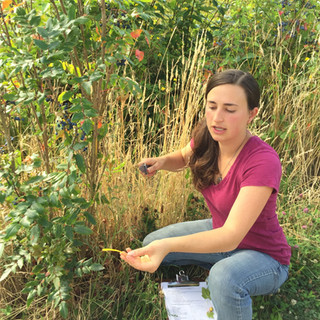All About Oregon Grape
- Natalie H.
- Aug 23, 2016
- 3 min read
I cannot sing enough praise about Oregon grape, and I count us as incredibly lucky to have it abundantly here in Washington. I teach about it in almost every class, because it's almost always present in whatever environment I'm teaching in. There a lot of uses for it, and I personally use it very frequently and have gotten a lot of success with it. It's a strong and straightforward plant.
There are two different species that we have in the Pacific Northwest: low Oregon grape (Mahonia nervosa), and tall Oregon grape (Mahonia aquifolium). The pictures above are all of tall Oregon grape, which grows in fields, bank landscapes, parking lots, and other areas that aren't the middle of the forest. It's a large plant, and it's my preference to harvest, because you can just saw off a super long branch at the bottom, and the bark comes off fairly easily. Low Oregon grape is a smaller plant found in the forest understory.
Harvesting the Yellow Bark:
I harvest this plant all year round, though usually barks are best harvested in the spring or fall. For tall Oregon grape, select a healthy branch from an abundant bush, and saw off near the ground. Scrape the bark off using a butterknife, veggie peeler or pocket knife when it is fresh, as it is very difficult to get off when dried. The bark should be bright yellow inside. The bark can be dried, or made into an infused honey or tincture, and the leftover wood can go in the yard waste bin, or used as magic wands.
Uses:
Because of its affinity for the liver, Oregon Grape makes a fantastic digestive bitter (and bitter it is!). Combine it with orange peel or other flavorful aromatic herbs in vodka to make a digestive bitters tincture. Take 30-60 drops before meals to improve assimilation of fats and proteins.
Recently, Oregon grape has become popular due to its anti-infection qualities. Like Goldenseal, it contains Berberine, which is what makes the root Yellow. Berberine-containing plants are used to kill organisms, especially in the GI tract and when used topically. I actually use Oregon grape most frequently for infections in or around the eyes. You make a tea by boiling the root in water for a few minutes on the stove. Strain through a cloth (you don't want any particulate in your eye). Dip a sterile cloth into the tea and place over your eyes, allow a little to drip into your eyes, but not too much. Do this several times as soon as you catch the infection, changing the cloth and reboiling or making new tea to prevent further infection.
It's also very effective in small doses for certain types of ulcers in the GI tract. I usually combine this with marshmallow root, which is very soothing.
Eczema can be caused by an imbalance in the liver, meaning that certain types of Eczema respond to Oregon grape. Try it by itself or combine it with yellow dock (Rumex crispus), which is another classic eczema remedy, and also grows in the area as a weed.
The Berries:
Oregon grape berries are edible, though not particularly delicious as they don't have a lot of sugar. They are incredibly high in Vitamin C, which makes them really sour. In my opinion, the best way to utilize the Oregon grape is in Jelly, which is incredibly delicious.
NOTE: Remember that whenever you take an herb into your body, it is your responsibility to do your research, make sure you have the correct plant, know the appropriate dosage, and pay attention to any negative side effects. Though some herbs may cause "healing crises" in some people, it's best to leave those situations to be managed by experts. For your own experimentations, always proceed cautiously and discontinue use if you don't feel well after consuming something.













